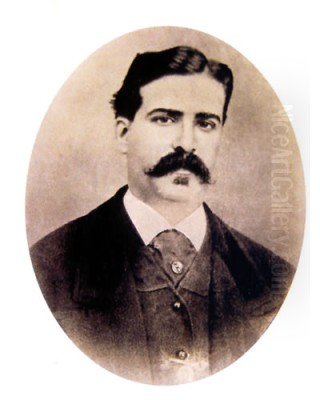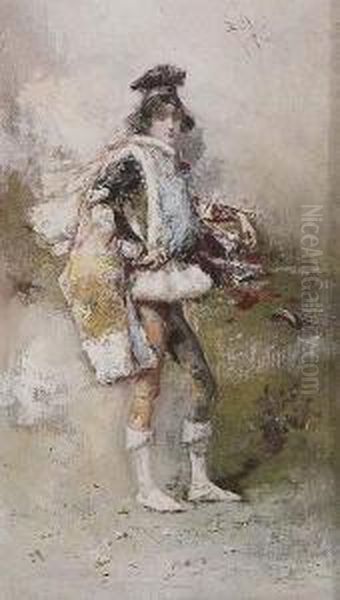
Salvador Sánchez Barbudo stands as a significant figure among the Spanish artists who sought inspiration and fortune in Italy during the late nineteenth century. Born in the vibrant Andalusian city of Jerez de la Frontera, near Seville, on March 14, 1857, he would spend a crucial part of his artistic career based in Rome, becoming a notable member of the thriving Spanish expatriate art community there. His work, deeply influenced by both his Spanish heritage and the artistic currents of his adopted Italy, primarily focused on historical genre scenes, evocative landscapes, and detailed figure painting, with a particular fondness for the unique atmosphere of Venice.
Early Life and Artistic Formation
Sánchez Barbudo's artistic journey began in his native Andalusia. Seville, a city rich in artistic history, provided the initial backdrop for his development. However, like many ambitious Spanish artists of his generation, he looked towards Italy, particularly Rome, as the essential destination for refining his craft and establishing his reputation. The legacy of Spanish masters who had previously found success in Italy, such as Mariano Fortuny, cast a long shadow and created a path many sought to follow.
In 1882, Sánchez Barbudo made the pivotal move to Rome. This city was not just the heart of the classical world but also a vibrant center for international artists. He integrated into the circle of Spanish painters residing there, a community that provided both camaraderie and artistic stimulation. Crucially, he studied under José Villegas Cordero, a highly influential Spanish painter who was himself a central figure in the Spanish art colony in Rome. Villegas Cordero played a significant role in shaping Sánchez Barbudo's style, particularly steering him towards the historical and genre subjects rendered with meticulous detail that would become his hallmark.
Artistic Style: The Neo-Renaissance and Venetian Influence

Sánchez Barbudo's artistic style is most accurately characterized as belonging to the Neo-Renaissance movement, with a specific emphasis on Venetian themes and aesthetics. His time in Italy immersed him in the masterpieces of the Italian Renaissance, particularly the Venetian school known for its rich color, dynamic compositions, and opulent subject matter. He absorbed these influences, adapting them to the tastes of the late nineteenth century.
His work often displays a strong sense of Romanticism, imbuing historical scenes with drama and evocative atmosphere. While sometimes broadly categorized within the period encompassing Impressionism and Post-Impressionism due to his working dates, his core technique remained rooted in academic precision and detailed realism rather than the looser brushwork and light effects characteristic of those movements. He excelled in rendering textures – silks, velvets, architectural details – and composing complex multi-figure scenes with clarity and narrative force. His palette was typically rich and vibrant, reflecting the Venetian influence.
A key aspect of his artistry was the successful fusion of his Spanish background with Italian influences. While his subject matter often leaned towards Italian history and Venetian life, the underlying sensibility sometimes retained a Spanish flair, perhaps in the intensity of expression or the specific character types he depicted. Italian critics, in particular, responded very positively to his work, recognizing his technical skill and his ability to capture the spirit of historical Italy.
Life and Work in Italy: Rome and Venice
Rome served as Sánchez Barbudo's primary base for much of his career after 1882. The city offered access to patrons, international exhibitions, and a stimulating environment shared with fellow artists. He became an established member of the Spanish community, maintaining connections with prominent figures like Federico de Madrazo, part of a dynasty of influential Spanish artists. Rome provided the historical weight and artistic resources that fueled his imagination.
However, Venice held a special allure for Sánchez Barbudo, as it did for many artists drawn to its unique beauty and historical resonance. He spent considerable time in the lagoon city, often collaborating with his friend and fellow Spanish painter, Rafael Senet. Together, they produced numerous works capturing Venetian landscapes and genre scenes. Their collaborative efforts were well-received, particularly by Italian critics who appreciated their romantic interpretations of Venice, possibly influenced by the lingering aesthetics of Italian Romanticism and even echoes of the Pre-Raphaelite attention to detail and mood.
His Venetian paintings are perhaps his most celebrated works. He moved beyond simple topographical views to capture the life and history of the city, specializing in scenes depicting the ceremonial splendor of the Venetian Republic, particularly focusing on the figure of the Doge and the Dogaresa (the Doge's wife) and their entourages. These works allowed him to indulge his interest in historical costume, elaborate settings, and grand narratives.
Major Themes and Representative Works
The dominant themes in Sánchez Barbudo's oeuvre revolve around history and the captivating allure of Venice. He was a master of the historical genre painting, a popular category in the late 19th century that allowed artists to showcase their skills in composition, detail, and narrative storytelling. His Venetian subjects were particularly successful, tapping into a widespread fascination with the city's past glory and unique atmosphere.
Among his most representative works are those centered on Venetian nobility and ceremony. Paintings like La triunfo de la Dogaresa (The Triumph of the Dogaresa) and La fiesta de la Dogaresa (The Feast or Wedding Celebration of the Dogaresa) exemplify his focus on the pomp and circumstance surrounding the leaders of the Venetian Republic. These works typically feature processions or gatherings filled with richly costumed figures, set against recognizable Venetian backdrops, rendered with meticulous attention to historical accuracy and opulent detail.
Another significant work is El bautismo del príncipe español en Venecia (The Baptism of the Spanish Prince in Venice), created around 1898. This painting, for which preparatory sketches also exist, demonstrates his ability to handle complex historical narratives involving numerous figures and intricate settings, blending Spanish historical elements with a Venetian context.
Other notable titles include El vestido de Venecia (The Venetian Gown), likely focusing on the elaborate fashions of the period, and Retrato de Dogo (Portrait of a Doge), showcasing his skill in portraiture within a historical context. His interest in historical and literary themes extended beyond Italy, as evidenced by a painting depicting the final scene of Shakespeare's Hamlet. Works like Caballero Renacentista (Renaissance Knight) further underscore his commitment to historical subjects. These paintings consistently demonstrate his fine brushwork, rich color sense, and ability to convey materiality and atmosphere.
Connections and Contemporaries
Salvador Sánchez Barbudo did not work in isolation. His career unfolded within a network of artistic relationships and influences. His teacher, José Villegas Cordero, was paramount in his early development in Rome, setting a standard for technical excellence and historical subject matter. His collaboration in Venice with Rafael Senet was also clearly significant, leading to a body of work focused on that city.
He was part of a notable generation of Spanish artists active in Italy. This group included figures like Francisco Pradilla Ortiz, famed for his large-scale historical paintings, José Benlliure Gil, another prominent painter of historical and genre scenes based in Rome, and Antonio Muñoz Degrain, known for his landscapes and historical subjects. While Joaquín Sorolla, a major figure in Spanish art, also spent time in Italy, his artistic path would eventually lead more towards Luminism, diverging from Barbudo's more academic style. The influence of the earlier generation, particularly Mariano Fortuny, continued to resonate within this circle, even though Fortuny himself had passed away in 1874, before Barbudo arrived in Rome. Fortuny's legacy of brilliant technique and exotic or historical genre scenes set a high bar.
Sánchez Barbudo's connections extended beyond the Spanish community. His interactions with British painters like John Elliott and the prominent Italian artist Giuseppe Aristide Sartorio, himself associated with Italian Romanticism and Symbolism, indicate his integration into the broader international art scene in Rome. Within the specific context of Venetian genre painting, his work finds parallels with Italian artists like Giacomo Favretto, who also specialized in lively depictions of Venetian life, albeit often with a more anecdotal focus. The mention of "Castillo" among Spanish painters influential in post-Renaissance styles likely refers to artists associated with the academic traditions, possibly José del Castillo or others carrying that lineage forward.
Reception, Recognition, and Art Historical Position
Salvador Sánchez Barbudo achieved considerable recognition during his lifetime. His works were exhibited not only in Italy but also in major art centers like Paris and Munich. He received accolades for his skill, including an award at the prestigious Madrid Fine Arts Exposition in 1886 and recognition at the Paris Salon in 1895. His paintings found favor with collectors who appreciated his technical polish, historical detail, and the romanticized visions of the past he created.
His reputation was particularly strong in Italy, where his dedication to Italian historical themes, especially Venetian subjects, resonated with local audiences and critics. They praised his ability to evoke the spirit of the Renaissance and the grandeur of Venice with both accuracy and artistic flair. He is remembered as a key figure among the Spanish expatriate painters who made significant contributions to the artistic life of Rome and Venice in the late 19th and early 20th centuries.
In art history, Sánchez Barbudo is positioned firmly within the academic tradition of the late nineteenth century, specializing in historical genre painting with a Neo-Renaissance aesthetic. He stands as a testament to the enduring allure of Italy for Spanish artists and the fruitful cross-cultural exchanges that occurred. While not an avant-garde innovator, he was a highly skilled practitioner of his chosen style, creating works admired for their craftsmanship, detail, and evocative power. His paintings offer a window into the tastes and artistic preoccupations of his era, particularly the fascination with historical revivalism and the romantic appeal of Venice.
Later Years and Legacy
Salvador Sánchez Barbudo remained dedicated to his art throughout his life. He continued to live and work primarily in Rome, the city that had become his artistic home for over three decades. His production of detailed historical and genre paintings continued, maintaining the high standards of technique and finish that had earned him his reputation.
His life came to an end in Rome on November 28, 1917. He left behind a body of work that celebrates the visual splendor of the past, particularly the rich history and unique atmosphere of Venice. His legacy is that of a talented and successful Spanish expatriate artist who masterfully navigated the academic traditions of his time, creating meticulously crafted paintings that continue to be appreciated for their beauty, historical detail, and romantic evocation of bygone eras. He remains an important representative of the Spanish contribution to the international art scene in Italy at the turn of the twentieth century.